Wednesday, August 15, 2007
Photo and Resource Bibliography
(b) http://en.wikipedia.org/wiki/Tranz_Metro
(c) http://en.wikipedia.org/wiki/Wellington_Urban_Motorway
(D) - (K) all photos obtained from the Wellington City Archives.
http://www.wikipedia.org/
http://www.wcl.govt.nz/wellington/trams.html
http://www.wellington.govt.nz/
http://www.teara.govt.nz/Places/Wellington/
other info and resources also collected from Wellington City Archives and the Film Archives.
Monday, August 13, 2007
Comparison between the patterns of old transportation and new transportation.
What is transportation?
2. the act of transporting or the state of being transported.
quoted from:COLLINS COMPACT ENGLISH DICTIONARY.
How has transpotation progressed?
Task 1
How has transportation influenced spatial patterns?
Our specific research objectives are:
1.What is transportation?
2.How has it progressed?
3.What pattern did 'old' transportation create?
4.What pattern has the new ways of transportation created?
5.Comparison between #3 and 4?
The information we think will be useful.
We plan to collect information and photographs to show change in Transportation, by using old photographs and maybe maps. We will also collect information from Books and the Internet that is relevant to or research Questions We will collect maps and photos from the Wellington City Archives and we will also collect Information from the Internet and from books like the ‘Wellington Portrait of the Region’ By Graham Stewart that book has many photos of places in Wellington in the past and in the present day. We will also go into town on the 7th of August 2007 to visit both the film and council archives. We will also take photos of the areas around Cuba and Manners Mall and down by Lampton Quay.
Where and how we intend to collect this information and how we are going to record it.
As a group we are going in to town to collect photos with our digital cameras and we are going to use them as evidence to back up our statements on transportation. We will also collect information from the council archives website and scam pages out of books to store on the computer.
Four different methods for presenting the information.
We plan to use a we plan to have a series of photo graphs, a table, a timeline and maps.
Sunday, August 12, 2007
Task Three:
The changes in transportation in Wellington have played a large part in the patterns of residential and commercial buildings in and around Wellington city. It has affected the way that the city operates and how it interacts with its hinterland.
Public transport in modern Wellington consists of buses, trolleybuses, trains, ferries and a funicular (the Wellington cable Car). Historically, it also included trams.From the 1850s sheep farms developed, and Otaki and Paekakariki became small service and railway towns to create a transport link to Wellington. By the 1870s it was clear that Wellington’s future as a trading centre rested on farming and so dairying dominated from the 1890s with factories at Otaki, Te Horo and Paraparaumu.
Improved roads and new railways linked the capital with its hinterland. In 1858 a road was built over the Rimutaka Range to the Wairarapa (part of Wellington province). By 1878 it was joined by a railway. The improved access encouraged farming in the Wairarapa.
In the 1930s Wellington obtained electric suburban trains, and today it is the only city with them. For this reason, Wellington is regarded as having the best passenger train system in New Zealand. Picture below: An electric suburban train at Wellington Train Station. (a)
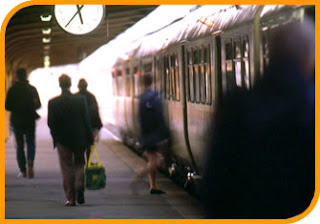
Between the 1880s and 1960s, many train stations were constructed on the Johnsonville, Hutt, Paraparaumu and Masterton lines with over 40 in use today.
These extensive railway lines have lead to urban sprawl with much of Wellington’s population living further a field in the suburbs. The picture below is a map of the modern Wellington railway system.(b)

The first trolleybus system in Wellington operated between 1924 and 1932.
The current trolleybus system in Wellington is much more extensive and has operated since 1949. Trolleybuses are an integrated part of the regular Wellington bus service, allowing easy and efficient travel in and around the CBD.
Ferries in Wellington also form a part of the Wellington public transport system, carrying commuters and tourists on the Wellington harbour. Today, ferries travel between central Wellington and Days Bay, Petone, Seatoun and Matui/Somes Island. They have previously served Miramar, Karaka Bay, and Eastbourne. The development of road connections around the harbour's edge has reduced the importance of ferries to the city's transport network, but regular services still run.
The importance of public transport to Wellington is clearly shown through through statistics. According to the Regional Council, around 35 million passenger trips are made by public transport in Wellington each year, and this number has been growing in recent years. Of the approximately 35 million trips, around 23 million are made by bus, 11 million are made by train, 1 million are made by funicular (the Wellington Cable Car), and 150,000 are made by ferry.
Motorway: The Wellington Urban Motorway is the major road into and out of Wellington. It is 7 km long, ranges from three to six lanes wide, and extends from the base of the Ngauranga Gorge into the Wellington CBD. It was built between 1969 and 1978. The motorway provides a direct route from the hinterland into the CBD, encouraging city workers to live outside of Wellington city and commute in from the suburbs. Below: The Wellington Urban Motorway in 1994, looking north out of Wellington. (c)

Saturday, August 11, 2007
What pattern did 'old' transportation create?
- Shipping
- Walking
- Horse
- Trams
- Cable Car
- Cars
- Trains
- Buses (trolley and diesel)
- Ferry
- Aeroplane
Shipping was the first form of transportation in Wellington. In the 1840's people settled around the Wellington harbour because of the easy access to the ports and shipping areas. This means that all the residential area were close to the port clustered together in walking distance. This is because many people would have had jobs at the port. The picture below was taken in 1887 and it is a picture of Queens wharf.  (D)
(D)
(Ref: The Wharf, Wellington Reference No: 00120:0:06, From the Wellington city council Archive)
Walking and Horse Riding is other forms of transport in the 1840's Wellingtons size was limited by how far you could walk or ride by horse because people had to live in walking distance or riding distance of their jobs and places that they could get supplies. Below is a picture of a horse and cart that used to be a common way to travel in the 1900 when the photo was taken. (E)

(Ref: Picot Brothers, Coal and Produce Depot, Hatton Street, Karori Reference No: 00138:0:1076, From the Wellington city council Archive)
The trams greatly effected transportation in Wellington they aloud people to live in Wadestown, Seatoun, Newtown and still have jobs in the City it also provided a quicker way of getting around the centre of Wellington The trams way in the city was opened in 1878 and ran for 86 years till 1964 in this time trams dominated the public transport in Wellington.
The first trams in Wellington looked more like small steam trains. Launched in August 1878, they consisted of a small steam engine. This tram were very noisy and for a time they change these steam engine trams to horse drawn trams.
1900 marked the year which saw the beginning of the changes that would lead to trams changing the face of Wellington.
On the 30th June 1904 the new era began with a short run through Newtown. Within months the main route through the city was completed and by 1907, trams were running through the Hataitai Tunnel to Kilbirnie, Miramar and Seatoun, through Berhampore to Island Bay, and up to Brooklyn and Karori Cemetery. These opened up large tracts of land and suburbs of Wellington began to boom. By 1911, extensions were laid to Karori Park and up to Wadestown.
For the next 50 years, life in Wellington was dependent on the tram as a means of transport, but gradually city planners began to realise that their days were numbered. Many of Wellington's streets were very narrow by Australasian standards and large trams lumbering down the centre-line of the road didn't mix well with increasing numbers of cars. Buses were seen to be the future, being much a more manoeuvrable and safer form of public transport. By the late 1950's routes began to close, and on 2nd May 1964, the last surviving tramcar route in New Zealand (Thorndon to Newtown) came to a close.

There are two photos below the first of a horse drawn tram (1900) and the other of the tramways in Newtown (1904).
(F)
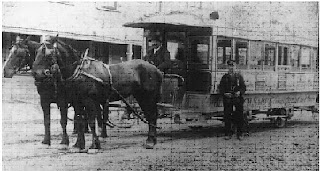
(Ref: Title: First horse tram in Wellington, Pictured in Newtown,Reference No: 00146:1:504, From the Wellington city council Archive)
(G)
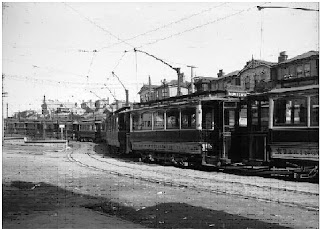
(Ref: Wellington City Corporation Tramways, tram to Newtown, Reference No: 00137:0:3, Wellington city council Archive)
At the end of the nineteenth century the hills around Wellington were still predominantly farmland. To provide transport facilities, a tramway was settled on. Initially it was proposed that the tramway could be built by private interests and then made available for sale to the Wellington City Council on completion. The cable, a mile long wire rope was wound up and down the track by a 12 foot driving wheel, then run around huge pulleys as either end of the track, and through the driving mechanism. The tramway was finally opened on the 22 February 1902, and during its first days of operation free tickets were offered to those interested in buying land in Kelburn. This can still be seen in Wellington today and the cable car is a Wellington icon. The photo below was taken in 1910 it is of the Cable Car.
(H)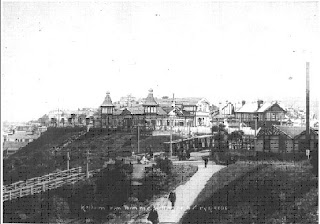
(Ref: Kelburn Cablecar Terminus and Kiosk Reference No: 00138:0:777, From the Wellington city council Archive)
The type of transport that effected Wellington the most would be the car. The car started to make a big difference in the 1950's and 1960's. The car aloud people to live in places that in the past it would have been imposable because it was to far to walk to town and there was no public transport. This meant that Wellington spread out and people did no need public transport so much.
Train came about very early in Wellingtons History. There was the Rimutaka incline opened in 1878 that aloud people to farm goods in the Waiarapa and transport them in to Wellington when the tunnel opened in1956 aloud people to live in the Waiarapa and work in Wellington. Then there was the railway track to Johnsonville and the Manawatu that opened in 1879 that aloud goods to come in from these area and for people to live out there instead of in the city even more so after electric trains came along. There were also trains that went to Tawa and Porirua that aloud people to move out the city and live out in those areas. Lastly there were trains that went to Auckland and Palmerston North aloud people to travel and to have goods come to Wellington from those areas. The picture below is of the Khandallah railway station in 1938.
(I)

(Ref: Khandallah Railway Station, electrification of the Johnsonville Line, Reference No: 00155:0:115, From the Wellington city council Archive)
Trolley Buses replaced the tram and still work on the same routes that the trams used so it did not effect Wellington that much. The Diesel buses effected Wellington a lot because they started up routes all around Wellington and the Hutt. Buses do not need tracks so they could go to many places that trains and trolley buses can not and people in areas like that area steep. This aloud people to spread around the hills of Wellington even more. The picture below is of the Trolley buses outside the railway station it was taken in 1964.
(J)
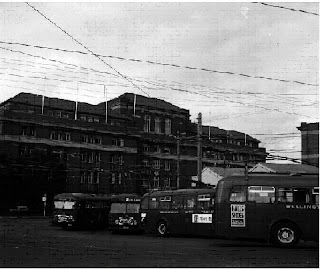
(Ref: Trolley Buses at Railway Station, Reference No: 00146:1:300, From the Wellington city council Archive)
The last form of transportation is Aeroplanes that aloud people to move around fast and get information from other countries . It also started tourism in Wellington this meant that more hotels were built in the central city and more tourist sites were created. Below is a picture of a old aeroplane flying over Wellington.
(K)
(Ref: Aeroplane flying over Wellington, Reference No: 00155:0:157, From the Wellington city council Archive)
The pattern that transport created in Wellington was the more developed it became the further away from Wellington people could live and still come in everyday to work. When walking was the most common from of transport people lived in the middle of wellington. Now you can live out in Kapti and come in to Wellington to work each day.
